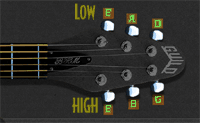

The notes played by the open strings of a guitar tuned in '
STANDARD TUNING ' where the A string
vibrates 440 times per second are as follows.
(there are other tunings possible which we won't go into here) .
E Bottom or low E this is the thickest string.
A = 440 vibrations per second.
D
G
B
E Top or high E this is the thinnest string.
Sometimes one of the confusions for the novice player, is
the fact that ' BOTTOM ' E - is the string which is
at the ' TOP ' of the guitar, when the instrument
is held in a playing position. What they are referring to, is the fact that this
the string which is ' LOWEST IN PITCH.'
' TOP ' E which is the thinnest string, situated at
the ' BOTTOM ' of the
guitar when held in the playing position, is the '
HIGHEST IN PITCH '
The other common method of identifying strings is numerically.
E - 6th ... Bottom or Low E
A - 5th
D - 4th
G - 3rd
B - 2nd
E - 1st ... Top or High E
The strings are numbered from the thinnest through to the thickest ' Top or High E = 1st String ' and ' Low or Bottom E = 6th String '
So why do some of the strings have
windings, and others do not?
This is simply because, the thicker a piece of wire, the slower it will vibrate,
therefore producing a lower note. Unfortunately, this also means that it becomes
less flexible and useless for playing purposes, The way round this, was to
produce a thin core wire which vibrated at a higher rate, then slow down the
vibration by winding another wire round the core, thus retaining the
flexibility, while producing the lower note required.
On a well made guitar, the strings should
not be so tight, that they are difficult to push down on to the fret-board.
These days, for £200 - £300 a reasonable instrument can be purchased.
At anything much lower than this price range, you are liable to be stuck with a
poor quality instrument, which could stunt your interest in learning to play
before you even get started.
If possible, take a knowledgeable friend along with you, when buying your first
instrument.
When you have your guitar take note of which way each string coils round it's individual tuning peg (see picture)
When you are first learning how to how to
tune a guitar, it is quite easy, to over tighten the string and actually snap it
- hence the need for a reasonably made instrument, to ensure that it is not a
major structural defect which is causing this problem -
To minimize the chances of this happening. As soon as you have lost track of the
pitch, slacken the string off until your a sure it has gone below the pitch of
the reference note, and try gradually creeping back up to it. - It may sound
obvious, but every guitarist has done it.- Always check the direction in which
you are turning the machine heads (another name for the tuning pegs) to make
sure that you are turning them in the correct direction. Especially if your
guitar has three machine heads each side of the headstock (as in picture ) Which
sometimes causes confusion due to the reverse nature of the layout -
in guitars with all six tuning pegs on one side or the other, this problem is
less common.
Click a radio button to play a note! The six notes are sampled from a Martin acoustic which was tuned with a quartz tuner to reference A = 440.
|
Has your computer got speakers and a microphone..?,,
If the answer's YES! |
|
Ok Your Tuned Up! |